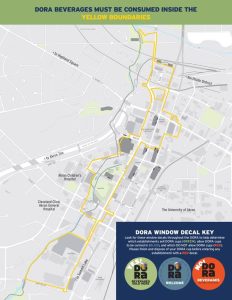The government said consumer prices rose 6.4% in January compared with 12 months earlier, down from 6.5% in December. It was the seventh straight year-over-year slowdown and well below a recent peak of 9.1% in June.
Yet it remains far above the Federal Reserve’s 2% annual inflation target, showing that the central bank still has work to do to ease pressures on the American people.
The figures released Tuesday are the latest sign that the high inflation that has gripped Americans for two years is slowing, but showed that inflationary pressures in the U.S. economy remain stubborn and are likely to fuel price spikes well into this year.
President Joe Biden on Tuesday called the report “good news for families and businesses across the country” while acknowledging that “there is still more work to do” to lower costs for Americans.
“That is why my unwavering focus is on continuing to lower costs for families, rebuild our supply chains, and invest in America,” the president said in a statement. “Right now, because of the Inflation Reduction Act we passed last year, we are lowering prescription drug costs, health care costs, and home energy costs for tens of millions of Americans all while lowering our deficits. My administration is eliminating junk fees which make it harder for American families to make ends meet at the end of the month. And we are creating manufacturing jobs all across the country, which will lower costs and rebuild our supply chains.”
Biden went on to criticize his Republican opponents, who control the House of Representatives, alleging that they “seem intent on taking us in the opposite direction.”
“They have proposed repealing the Inflation Reduction Act, which would make inflation worse, shower billions of dollars on Big Pharma, and increase the deficit,” he said. “They are threatening to raise costs for seniors by threatening to cut Medicare and Social Security, and other critical programs that American seniors and families count on. And some are threatening to default on the full faith and credit of the U.S., which would raise costs and create economic chaos.”
“I will stand firmly against any effort to make inflation worse and increase costs for families,” the president promised. “Today’s data reinforces that we have made historic progress and are on the right track, and now we need to finish the job.”
On a monthly basis, consumer prices increased 0.5% from December to January, much higher than the 0.1% rise from November to December. More expensive gas, food and clothing drove up inflation in January.
The Fed has aggressively raised its benchmark interest rate in the past year to its highest level in 15 years in its drive to get rampaging inflation under control. The Fed’s goal is to slow borrowing and spending, cool the pace of hiring and relieve the pressure many businesses feel to raise wages to find or keep workers. Businesses typically pass their higher labor costs on to their customers in the form of higher prices, thereby helping fuel inflation.
So far, most of the slowdown in inflation reflects freer-flowing supply chains and sinking gas prices. But the Fed’s rate hikes — eight since March of last year — have had no discernible effect on America’s job market, which remains exceptionally strong.
The unemployment rate has dropped to 3.4%, the lowest level in 53 years, and job openings remain high. The strength of the job market has, in turn, helped support consumer spending, which underpins the bulk of the U.S. economy.
Average wages are rising at a brisk pace of about 5% from a year ago. Those pay gains, spread across the economy, are likely inflating prices in labor-intensive services. Powell has often pointed to robust wage increases as a factor that’s driving up services prices and keeping inflation high even as other categories, like rent, are likely to decelerate in price.
Many economists expect inflation to fall to roughly 4% later this year. But it could plateau at that point so long as hiring and wage gains remain vigorous. The Fed might then feel compelled to keep borrowing rates high well into 2024 or even raise them further this year.
The Biden White House last week calculated a measure of wages in service industries excluding housing — the sector of the economy that Powell and the Fed are most closely tracking. The administration’s Council of Economic Advisers concluded that wages in those industries for workers, excluding managers, soared 8% last January from a year earlier but have since slowed to about a 5% annual pace.
That suggests that services inflation could soon slow, especially if the trend continued. Still, wage gains of that level are still too high for the Fed’s liking. The central bank’s officials would prefer to see wage growth of about 3.5%, which they see as consistent with their 2% inflation target.
A key question for the economy this year is whether unemployment would have to rise significantly to achieve that slowdown in wage growth. Powell and other Fed officials have said that curbing high inflation would require some “pain” for workers. Higher unemployment typically reduces pressure on businesses to pay bigger wages and salaries.
Yet for now, the job market remains historically very robust. Powell said last week that the jobs data was “certainly stronger than anyone I know expected,” and suggested that if such healthy readings were to continue, more rate hikes than are now expected could be necessary.
Other Fed officials, speaking last week, stressed their belief that more interest rate increases are on the way. The Fed foresees two more quarter-point rate hikes, at its March and May meetings. Those increases would raise its benchmark rate to a range of 5% to 5.25%, the highest level in 15 years.
The Fed lifted its key rate by a quarter-point when it last met on Feb. 1, after carrying out a half-point hike in December and four three-quarter-point increases before that.
The financial markets envision two more rate increases this year and don’t expect the Fed to reverse course and cut rates until sometime in 2024. For now, those expectations have ended a standoff between the Fed and Wall Street investors, who had previously been betting that the Fed would be forced to cut rates in 2023 as inflation fell faster than expected and the economy weakened.




